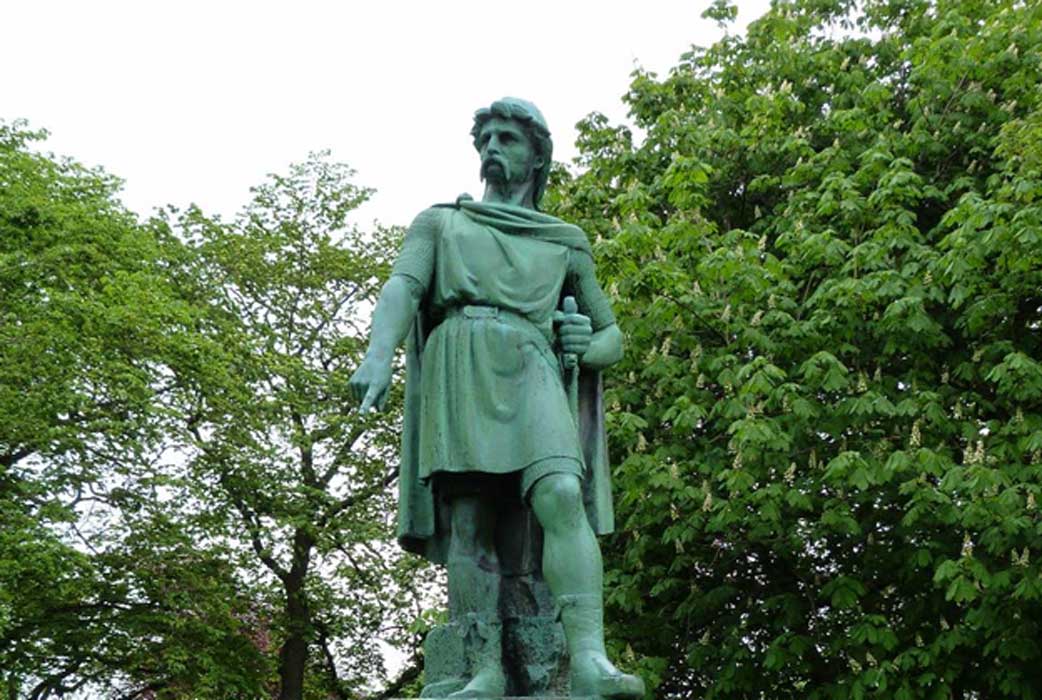Clameur de Haro: Feudal Law Brings Construction Project To a Standstill
Rosie Henderson, from Guernsey, activated the ancient Norman rite of Clameur de Haro in protest of “the narrowing of a road” which she claims “would endanger pedestrians and motorists,” according to a report in The Guardian.
On Tuesday, Henderson kneeled near the roads of Les Échelons and South Esplanade and called for help, before reciting the Lord’s Prayer in Norman French, which legally raised the clameur, an ancient legal act which remains fully enforceable in Guernsey and Jersey law. Her curious actions worked for a time and brought construction work in St Peter Port to a stop until a court made a decision on the clameur .

Rosie Henderson invoking the ‘Clameur de Haro’ (BBC)
Unfortunately for Henderson, ITV reports the courts rejected her plea “due to the land in question being owned by the States.” Nonetheless, Henderson encourages other islanders to exercise their rights using this ancient system.
What is the Clameur de Haro?
Raising a clameur dates back to at least the 10th century and the early Norman period in the Channel Islands. It is traditionally believed to have been a plea to Rollo, the first Duke of Normandy while he maintained a state of feudal law rather than providing law enforcement. Advocate St John Robilliard told reporters "In Ancient Norman times it would be used not simply to protect your land, but to protect any sort of property rights and indeed in criminal law matters, if someone was attacking you or your property you would raise it.”
- The brutal Draconian laws of ancient Greece
- The Haensa - Thorir Saga: A tale of law in Medieval Iceland
- Hammurabi and his God Given Code of Laws
The clameur stated “Haro! Haro! Haro! A l’aide, mon prince, on me fait tort”, translated as “Come to my aid, my prince, for someone does me wrong,” according to an article in The BBC. And, frustratingly to the construction company it was called against, they must stop all building and construction works immediately while whoever calls the clameur has 24 hours to register it in court.

Rollo, Duke of Normandy. (Public Domain)
Laws with Ancient Origins
This story began in 2016 when plans to level St Peter Port’s sunken gardens were withdrawn after protesters threatened to use the Clameur de Haro to block the construction. Deputy Bailiff Richard Collas refused to register the Clameur de Haro, and Andy and Hege Bougourd are currently involved in “a dispute with planners over the size of the house they built in St Andrew.”
According to the BBC article, “The bank that lent them money for the build were threatening eviction and they hoped invoking the law would halt the action.” “The clameur was refused as the bank was not doing anything wrong” added Bougourd, who stated that “he and his wife would continue to fight the case,” which goes before the Royal Court on Friday.
Speaking of the Clameur de Haro, Advocate Robilliard told reporters: "They don't happen very often today. I think for two reasons, firstly where you can raise it is far more limited than the instances it appears in history and secondly very often injunctions are sort from the court, because when you raise the clameur it is like an injunction, which you do before you go to court.”

Drawing by J R Le Couteur of a man invoking the Clameur de Haro to save a tree. (theislandwiki)
UK law is threaded with some really old bylaws and clauses which still stand up in court today. These are a few featured on Britain explorer.com:
The Metropolitan Streets Act 1867 “ prohibits the driving or conducting of any cattle through any street between the hours of 10.00 in the morning and 7.00 in the evening.” The maximum penalty is a £200 fine for each head of cattle.I tol
- Solon: The Father of Western Law
- The Code of Ur-Nammu: When Ancient Sumerians Laid Down the Law, Everyone Obeyed
- The City of Refuge: Ancient Hawaiian Sanctuary Protected Law Breakers from Death Sentence
Mute swans are protected under the wildlife and countryside act of 1981 and “ It is illegal to eat Mute Swan unless you’re the Queen of Great Britain.” Killing one can land you with a £5,000 fine or up to six months in prison.

Mute swan (Cygnus olor) and cygnets, Wolvercote Lakes, Oxford. (Charles J Sharp/CC BY SA 4.0)
The Alcohol Licensing Act of 1872 states “ It is an offense to be intoxicated (drunk) and in charge of a cow in Scotland.” This curious law extends to horses and steam engines. Breaking it carried a penalty fine of up to 1,200 GBP, excluding the costs of someone looking after the animal while you were incarcerated.
This short list of old laws reveals some of the aspects which affected everyday life, and it is rather saddening to look at modern laws designed to ensnare todays criminal, for example, “ It is illegal under the terms of the Prohibition and Inspections Act of 1998 to cause a nuclear explosion.” The fact that such a law exists is understandable, but why a ‘nuclear explosion’ was given a special law, in front of all the endless other potential threats to national security, remains a mystery.
Top image: Statue of Rollo, Duke of Normandy in Ålesund, Norway. The Clameur de Haro is traditionally believed to have been a plea towards this ruler. Source: CC BY SA 4.0
By Ashley Cowie



















